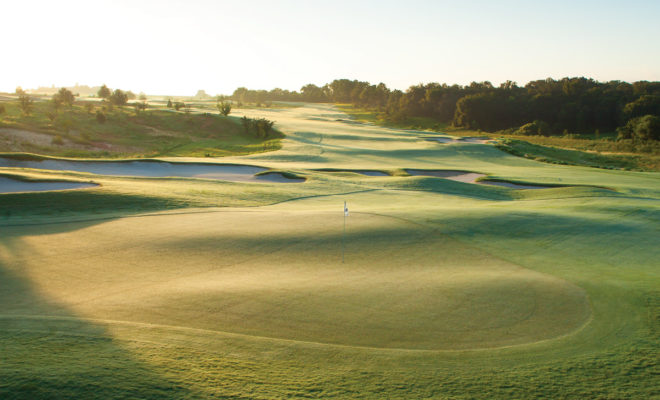Winter Golf in the California Desert: From one end of the Coachella Valley to the other, quality and choice are the name of the game.

Winter in Palm Springs is better than summer in most places. That the Coachella Valley is in Southlanders’ backyards, an easy drive away, sure gives So Cal-ers a distinct advantage to those in, say, Grand Rapids or Toledo staring glumly across the snowscape and realizing that relief and a tee time ‘neath swaying palms are a long flight away. So put that easy proximity to advantage, and tack on a couple days for good measure. There’s a desert golf getaway for all tastes and every budget.
Luxury
La Quinta Resort & Club/PGA WEST
La Quinta
The TPC Stadium Course at PGA WEST is the site of many dramatic moments in golf, perhaps none as memorable as when, during the 1987 Skins Game, Lee Trevino aced his tee shot on the island green at No. 17, winning a carry-over skin worth $175,000, and proceeded to prance and leap into his caddie’s arms. That moment, televised nationally on Thanksgiving Day, firmly entrenched the Stadium Course, PGA WEST and the city of La Quinta in the public mind as a golf mecca.
 The TPC Stadium Course is one of five courses available to guests of La Quinta Resort & Club, the California desert’s iconic getaway retreat. Arriving at the resort, motoring down the resort’s palm-and-cypress-lined drive, arriving at the reception area and plaza, hacienda-styled in mission-white plaster, azure trim and red-tile roofing is a throwback experience. A classic Duesenberg would be an apt conveyance, yet whether your car is classic or modern, La Quinta is simply inviting.
The TPC Stadium Course is one of five courses available to guests of La Quinta Resort & Club, the California desert’s iconic getaway retreat. Arriving at the resort, motoring down the resort’s palm-and-cypress-lined drive, arriving at the reception area and plaza, hacienda-styled in mission-white plaster, azure trim and red-tile roofing is a throwback experience. A classic Duesenberg would be an apt conveyance, yet whether your car is classic or modern, La Quinta is simply inviting.
Crafted and expanded with love over a span of nearly 90 years, the resort stays current as it embraces the past. Surrounded by a toe-tickling expanse of grass and shaded by La Quinta’s signature citrus trees, an array of villas, suites and spacious rooms huddle in inviting clusters, oriented around pools, spas and courtyards. Legendary film director Frank Capra wrote often from his favorite hideaway, #136.
The getaway quotient continues to soar with a world-class tennis center, 41 pools — not a typo — 53 hot tubs, spa and fitness facilities, seven restaurants and a village square — in regional parlance the plaza — lined with shops, vibrant with flowers, twinkle-lighted olive trees and cascading waters; not a bad place to while away the dusk hour.
Two of La Quinta’s five courses play out from a clubhouse an easy stroll away, Dunes and Mountain — both recently revived and refreshed. (Dunes reopened in late November and Mountain is slated to follow during the first quarter of 2014.) Dunes showcases the work of Pete Dye when he’s not all cranky and cantankerous and set on kicking golfer tail. The routing is generously sideboarded, hazards and bunkers more visually defining than direly threatening, and the green approaches are navigable; it’s a good arrival-day play. Mountain is, to many, the better of the two. The course plays along and then into the rocky lower crags of the Santa Rosa Mountains, topped off by the all-desert three-hole run from 14 through 16.
Nearby PGA WEST was one of the first of the modern desert golf-and-lifestyle developments to put as much emphasis on golf as being an enviable place to reside. Dye’s Stadium Course gets the print and the notoriety, a place that once hosted the PGA Tour-istas, and then chewed ‘em up so badly that after one go around they never came back, though the Tour had no qualms sending Q School out there.
Regular Joes and Joans might find the Nicklaus Resort spread to be more exacting. Though there’s more give in the seams off the tee, Nicklaus makes getting safely home more than just a walk in the park. Rounding out the troika, Greg Norman’s namesake course comes at players with a greener approach to the green stuff, with far less turf coverage than is typical and a freeform alliance as fairways give way to waste areas to hazard or gunch in an organic flowing fashion.
But whatever words you use to describe La Quinta Resort and PGA WEST, it’s also about the math: the number is 90, as in holes of golf. If Capra was alive he might be moved to write, “Now that’s a wonderful life.”
BOOK IT
Accommodations: Staring at $249 (exclusive of tax); unlimited golf packages for two begin at $549.
Resort Fees: $27; parking is free
Green Fees: From $129 for hotel guests and $159 for the public (and pricing varies by course).
Moderate
Indian Wells Golf Resort
Indian Wells
So much of the valley’s golf history is cloaked in the spectacle of the game. Big tourneys to have transpired in the area have included two Ryder Cups (1955, ’59), the Skins Game, the first major of the year on the LPGA (Kraft Nabisco Championship) and one of the longest-running, most successful and charitable events of the PGA TOUR (The Humana Challenge).
 But sometimes it’s nice just to play a lot of golf, chill and hang out. If that describes what you are looking to accomplish on your next retreat, Indian Wells Golf Resort is the place. The golf side of the equation is a 36-hole complex owned by the city of Indian Wells. The original layouts from the 1980s were sporty, resort-style romps courtesy of the late Ted Robinson; think openness, floral extravagance and eye-pleasing water features, notably on his oh-so-signature par 3s.
But sometimes it’s nice just to play a lot of golf, chill and hang out. If that describes what you are looking to accomplish on your next retreat, Indian Wells Golf Resort is the place. The golf side of the equation is a 36-hole complex owned by the city of Indian Wells. The original layouts from the 1980s were sporty, resort-style romps courtesy of the late Ted Robinson; think openness, floral extravagance and eye-pleasing water features, notably on his oh-so-signature par 3s.
In 2006 and 2007, respectively, the old West and East courses were chucked and re-done from the roots up, emerging as the Clive Clark-designed Celebrity Course and John Fought’s Players Course. Save a handful of fairway corridors, not much else remains.
Celebrity does retain some of the old stylistic charms, with an arboretum-grade landscape tableau, and it’s also divinely wet, with lakes and waterways now fully integrated into the design fabric and the playing strategy. Clark worked magic with shorter par-4s that can stand up and deliver a roundhouse to the brazen. It’s all very stylistic, and wonderfully aesthetic.
Fought (rhymes with ‘boat’) counters with a more assertive approach and a contemporary philosophy of design that has no problem hiding greens or rendering shots blind or semi-blind, or matching a classic-era cape to a brawny heroic-era bruiser on the next hole. And both play out of the most elegant, extravagant clubhouse this side of, well, anywhere, accented with tumbling curtains of water, fire features, views of the mountains that gird the valley, one of the desert’s best restaurants and if your game or equipment aren’t quite on, a Callaway Golf Performance Center.
Though 36-hole days are the epitome of a golf getaway, there remains that whole vacation side of things. Four resorts provide that component at Indian Wells. Mix and match as taste and price dictate, though we’re leaning to Hyatt Regency Indian Wells Resort & Spa this time around.
Walking distance to the golf clubhouse, the Hyatt is stately cool to La Quinta’s hacienda-chic. Standard rooms here are capacious, with the boudoir leading a few steps down to the living area, and beyond a balcony or patio with pool, garden or course views. Double doors lead to a bath with a huge shower and man-sized tub.
Multiple bars and eateries are found on property, along with seven pools, a renowned tennis center and one of the desert’s most acclaimed spas, all of which should keep guests from needing to go on walkabout. But if you do, grab the putter and hoof on over to the club’s Fought-designed, lighted, nine-hole putting course. The record is 17 . . . held by some guy named Mediate who lost to Tiger Woods in the 2008 U.S. Open.
BOOK IT
Accommodations: Standard rooms start at $179/night; unlimited golf packages for two begin at $509.
Resort Fees: $26 resort fee
Green Fees: $175 per player
Budget
Renaissance Palm Springs
Palm Springs
The valley’s first inhabitants, the ancestral Cahuilla, lived across the interface of desert and mountain, moving seasonally in rhythm to life’s cycles. On the edges and down on the valley floor, most abundantly in the area now known as Palm Springs, they found palms, fresh water both hot and cold, sustenance, winter warmth; the very things, in some form, that later would entice so many tourists.
In times historic and current, the heart of the desert was and is Palm Springs. It’s not the largest city in the desert, nor the oldest. It doesn’t have the largest concentration of golf courses nor the most famous. What it has is a pulse, a buzz, a cultural and social vibe . . . the springs has soul.
 Renaissance Palm Springs is a perfect base of operations for high-value free agents looking to maximize their desert golf and vacation experiences. Large, subtly well-appointed rooms are the first draw, backed by the largest pool and most active pool scene in the western valley, capped by evening cocktails fireside under the star-dappled desert sky and wrapped in a setting just a few blocks from the life and lights of Palm Canyon Drive and downtown.
Renaissance Palm Springs is a perfect base of operations for high-value free agents looking to maximize their desert golf and vacation experiences. Large, subtly well-appointed rooms are the first draw, backed by the largest pool and most active pool scene in the western valley, capped by evening cocktails fireside under the star-dappled desert sky and wrapped in a setting just a few blocks from the life and lights of Palm Canyon Drive and downtown.
For all the village core has to offer, Palm Springs does restaurants like the desert does golf courses, meaning loads and loads. Narrow it down however you want, you’re not likely to get burned, but for a funky night out with twisted libations, killer seafood and live music Friday and Saturday nights, set course for Shanghai Reds Bar & Grill
Escena Golf Club is Renaissance’s course partner, a 2009 creation of Nicklaus Design. Palm Springs’ newest play, Escena pulled some of the eastward-rolling golf tide back to the originator of desert golf. Escena golf is played in two dimensions, a dramatic vertical quality that is the visual backdrop of the San Jacinto, Santa Rosa and the Little San Bernardino mountains, faraway tapestries that provide a stunning amount of depth of field. On the ground, the course spreads broadly, inviting boulevards of play given character and shape through subtle collection areas, meandering wastes and water and fairway kinks.
Fans of the a la carte portion of the menu do well with servings of Tahquitz Creek Golf Resort and Indian Canyons Golf Resort’s South Course. Indian South was a mid-century parkland layout on tribal lands recently brought roaring into the new millennium by a near-complete makeover. Urban intrusions are minimal and several of the best older elements — towering palms, the course’s at-hand proximity to the southerly ranges and palm canyons, and most notably the best hole on-course, the banking par-5 third — remain. Redesign consultant Amy Alcott ensured that Indian South is both a front-tee-friendly and front-tee-relevant play.
Tahquitz Creek is a 36-hole facility with one course that jumps up demanding attention, and at this city of Palm Springs-owned facility it’s the blandly named yet intriguing Resort Course. Resort shows some of the design cues of Ted Robinson, notably in the use of water. Interesting, approachable green complexes are the norm.
BOOK IT
Accommodations: Starting at $149/night (varies on dates of stay)
Resort Fees: None
Green Fees: Escena: $125/per player; Indian Canyon South Course: $115/per player; Tahquitz Resort Course: $99/per player
www.marriott.com/hotels/travel/pspbr-renaissance-palm-springs-hotel











